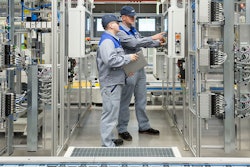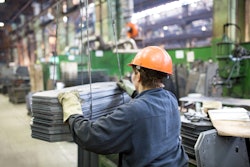‘Tis the season for resolutions. The end of one calendar year and the start of the next is a traditional time for reflecting on the past and forecasting the future. Shortcoming and opportunities can come into sharp focus, along with commitments to improve and the funding to make it happen. For plant maintenance teams, a high volume of emergency service requests is frequently a top issue. Jumping from one urgent work order to the next is highly inefficient and disruptive. Fortunately, technology can help manufacturers turn over a new leaf and strive for a more proactive approach to maintenance in the coming year.
Common Issues to Overcome
Poor maintenance strategies can reduce a plant’s overall productive capacity by 5-20 percent, according to consulting firm Deloitte. They estimate that unplanned downtime costs industrial manufacturers $50 billion each year.
Once a plant is in reactive mode and is chasing emergencies, it is hard to get in front of the issue, especially if the equipment is past its prime. For many, the recent recession exacerbated a downward spiral of asset wellness as capital investments were postponed. Manufacturers often had to make do with outdated assets and patched solutions. Now, as the national economic outlook improves, factories hungry for growth are racing to adopt digital technologies and deploy advanced innovations to increase responsiveness, agility, and customer engagement.
Impeding Progress
Enterprises are rolling out new customer-centric services; new partnerships are on the horizon, and key Internet of Things (IoT) and Artificial Intelligence (AI) initiatives are being tested. It is more important than ever that machinery and equipment perform as needed. It is a high-stakes landscape. No company wants to risk highly visible disruption damaging credibility while in the midst of negotiating a merger or signing a multi-year customer contract.
This is why turning to proactive asset maintenance and Condition-Based Monitoring (CBM) is so important today. Manufacturers on the cusp of a new era need their machinery operating at peak performance. If current systems are performing as needed, technicians can focus on other priorities such as new deployments, embracing sensor technology, reducing waste, improving sustainability and scaling for expansion.
Where to Begin?
Enterprise Asset Management (EAM) solutions are a necessity to tracking and monitoring complex plant assets. The more complex the asset, the more critical it is for systems to help manage the high-tech components. Computerized machinery with digital displays, built-in safety protocols, voice recognition and AI-assisted functionality often require version upgrades. Security updates and data back-ups are other ongoing tasks that modern cloud-connected equipment, like robotics, may require. Yesterday’s maintenance solution will be ill-equipped to keep pace with the challenges.
Modern EAM solutions, though, bring a wealth of features which make proactive equipment service feasible. Manufacturers can up-level their goals and re-set expectations, focusing on prevention rather than repair.
EAM Maturity Model
Manufacturers using EAM solutions typically mature to greater sophistication, each stage representing more advanced applications and fuller use of the functionality:
- Reactive. Works on equipment when it fails.
- Conscious. Still reactive but rebuilds major components and has spares available.
- Preventive. Uses routine inspections, lubrications, adjustments, etc. to improve equipment availability.
- Predictive. Sensors monitor conditions, like vibration, to spot early warning signs of maintenance needs.
- Consumptive. Sensor data triggers automatic response. Technicians focus on data analysis and maintenance priorities.
- Condition Based Monitoring. This approach generates a detailed index rating for each asset, monitoring a wide range of factors from expected lifespan and critical ranking of the asset to expected cost and time to replace. This allows managers to see at a glance where the most pressing issues are lurking.
Asset managers can see beyond the surface-level checklist of common issues, like flat tires or belts that need to be replaced. With CBM, it becomes possible to understand the complex interrelationships of multiple factors at once and answer more difficult questions, such as whether an ailing asset should be repaired, upgraded or replaced.
Benefits
Independent surveys indicate the following industrial savings can be achieved when CBM is deployed:
- Reduction in maintenance costs: 25 to 30 percent
- Elimination of breakdowns: 70 to 75 percent
- Reduction in equipment or process downtime: 35 to 45 percent
- Increase in production: 20 to 25 percent
Maintenance technicians often struggle to interpret anecdotal reports from users about assets not living up to expectations or complaints of assets failing, citing only vague or unknown reasons. The lack of clarity can add to the delays. A clearly defined index system which assigns points to an asset based on measurable facts, not frustration, makes it easier to make objective evaluations.
This type of objectivity also helps cost-justify investment. A CBM approach provides the ability to investigate “what if” scenarios, consider many influencing factors and develop long and short-term plans based on priorities. Data can be used to make pragmatic proposals to top decision-makers, showing justification of equipment upgrades or replacement.
Final Takeaway
Manufacturers are in a pivotal position. Opportunities for growth are within reach as market conditions improve and digital technologies promise to unlock new revenue models, automation, and customer alignment. The existing plant assets, from cranes to packaging equipment and forklift, can either support the vision, or hinder it. Delays from unexpected downtime and the need for frequent emergency repairs can easily become a drain on the organization—just when optimal performance is needed most. It does not have to be that way. Setting resolutions to be more proactive will help the asset maintenance team make better use of resources, helping the enterprise feel confident about its critical shop floor equipment.
Nick Castellina is Director of Industry and Solution Strategy at Infor.























